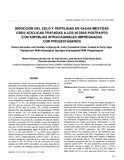Mostrar el registro sencillo del ítem
Inducción del celo y fertilidad en vacas mestizas cebu acíclicas tratadas a los 40 días postparto con esponjas intravaginales impregnadas con progestágenos
| dc.rights.license | http://creativecommons.org/licenses/by-nc-sa/3.0/ve/ | |
| dc.contributor.author | Palomares, Roberto | |
| dc.contributor.author | De Ondiz, Aitor | |
| dc.contributor.author | Sandoval, Jorge | |
| dc.contributor.author | Román Bravo, Rafael | |
| dc.contributor.author | González Fernández, Rumualdo | |
| dc.contributor.author | Soto Belloso, Eleazar | |
| dc.date.accessioned | 2009-04-14T17:56:53Z | |
| dc.date.available | 2009-04-14T17:56:53Z | |
| dc.date.issued | 2009-04-14T17:56:53Z | |
| dc.identifier.issn | 0798-2259 | |
| dc.identifier.uri | http://www.saber.ula.ve/handle/123456789/27703 | |
| dc.description.abstract | Para estudiar el efecto del uso de esponjas intravaginales impregnadas con Acetato de Medroxiprogesterona (MAP) sobre la inducción temprana del celo y prevención del anestro postparto, se llevó a cabo un ensayo en una finca comercial en el municipio Rosario de Perijá del estado Zulia, Venezuela. 76 vacas mestizas acíclicas fueron asignadas a tres tratamientos a los 40-47 días postparto: Progesterona más Estradiol (MAP+E, n=26); Progesterona más GnRH y PGF2a (MAP+GnRH, n= 26) y testigo (T, n= 24). Las variables estudiadas fueron: Tasa de celo (TC), tasa de ovulación (TO), tasa de concepción al primer servicio (TCPS), tasa de preñez (TP), intervalo tratamiento - servicio (ITS), tasa de preñez a los 120 días postparto (TP120), tasa de anestro (TA). Los niveles de Progesterona en leche fueron medidos por R.I.A., para determinar los ciclos ovulatorios. Las variables fueron analizadas a través de procedimientos de frecuencias y la prueba de Ji-cuadrado del paquete estadístico SAS, a excepción del ITS, medido a través de análisis de varianza. MAP+GnRH presentó mayor TC (62,5%) en comparación con T (27,3%) (P<0,05), pero fue similar a MAP+E (47,6%). La TO fue significativamente mayor (P<0,05) en MAP+GnRH (57,1%) vs 25% para MAP+E y T. La TCPS estuvo negativamente afectada por los tratamientos MAP+E y MAP+GnRH con 10,0% y 26,7%, respectivamente vs 66,7% para T. No se encontraron diferencias significativas (n.s) entre los tratamientos en cuanto a ITS, TP, TP120 y TA. En conclusión, las vacas tratadas con MAP+GnRH presentaron una mejor respuesta de celo y ovulación; sin embargo, ninguno de los tratamientos con esponjas intravaginales en el postparto temprano fueron efectivos en mejorar la eficiencia reproductiva y prevenir el anestro postparto. | es_VE |
| dc.rights | info:eu-repo/semantics/openAccess | |
| dc.subject | Esponjas intravaginales | es_VE |
| dc.subject | Progesterona | es_VE |
| dc.subject | Estradiol | es_VE |
| dc.subject | Anestro postparto | es_VE |
| dc.subject | Vacas mestizas | es_VE |
| dc.subject | GnRH | es_VE |
| dc.title | Inducción del celo y fertilidad en vacas mestizas cebu acíclicas tratadas a los 40 días postparto con esponjas intravaginales impregnadas con progestágenos | es_VE |
| dc.title.alternative | Estrus induction and fertility in noncyclic cebu crossbred cows treated at forty days postpartum with intravaginal sponges impregnated with progestagens | es_VE |
| dc.type | info:eu-repo/semantics/article | |
| dc.description.abstract1 | In order to study the effects of using intra-vaginal sponges impregnated with Medroxi-progesterone acetate (MAP) on early estrus induction and prevention of postpartum anoestrus, a test was carry out on a commercial farm located in the Rosario de Perijá county in Zulia state, Venezuela. 76 non-cyclic crossbred cows (B. taurus x B. indicus) were used, between 40 and 47 postpartum days and were randomly allotted to the following treatments: Progesterone plus Estradiol (MAP+E, n=26); Progesterone plus GnRH and PGF2a (MAP+GnRH, n= 26) and Control (T, n= 24), without any treatment. The variables studied were: estrus rate (ER), ovulation rate (OR), first service conception rate (FSCR), pregnancy rate (PR), treatment - service interval (TSI), pregnancy rate at 120 postpartum days (PR120), and anoestrus rate (AR). Progesterone was measured by R.I.A in milk samples taken twice weekly to determine ovulation after sponge removal. The variables were analyzed by frequency procedures and the chi-square test of statistical analysis system (SAS). TSI was analyzed by variance model. MAP+GnRH showed a higher TC (65.2%) than T (27.3%) (P<0.05), but similar to MAP+E (47.6%). TO was higher in MAP+GnRH (57.1%) vs 25% than both MAP+E and T groups (P<0.05). TCPS was negatively affected by MAP+E and MAP+GnRH treatments with 10.0% and 26.7%, respectively vs 66.7% in the T group. No effects were found due to the treatments on PR, PR120, AR, TSI. In conclusion, the cows treated with MAP+GnRH showed a higher estrus and ovulation rate, however; neither of the treatments with intravaginal sponges were effective in improving reproductive performance in early postpartum or in preventing postpartum anoestrus. | es_VE |
| dc.description.colacion | 371 - 378 | es_VE |
| dc.description.frecuencia | Bimestral | |
| dc.identifier.depositolegal | 199102ZU46 | |
| dc.subject.institucion | Universidad del Zulia (LUZ) | es_VE |
| dc.subject.institucion | Universidad de Los Andes (ULA) | es_VE |
| dc.subject.keywords | Intravaginal sponges | es_VE |
| dc.subject.keywords | Progesterone | es_VE |
| dc.subject.keywords | Estradiol | es_VE |
| dc.subject.keywords | Postpartum anoestrus | es_VE |
| dc.subject.keywords | Crossbred cows | es_VE |
| dc.subject.keywords | GnRH | es_VE |
| dc.subject.publicacionelectronica | Revista Científica | |
| dc.subject.tipo | Revistas | es_VE |
| dc.type.media | Texto | es_VE |
Ficheros en el ítem
Este ítem aparece en la(s) siguiente(s) colección(ones)
-
Revista Científica - 2002 - Vol XII - No. 005
septiembre - octubre



